-
LM36010 Synchronous-Boost, Single-LED Flash Driver With 1.5-A High-Side Current Source
- 1 Features
- 2 Applications
- 3 Description
- 4 Revision History
- 5 Pin Configuration and Functions
- 6 Specifications
- 7 Detailed Description
- 8 Applications and Implementation
- 9 Power Supply Recommendations
- 10Layout
- 11Device and Documentation Support
- 12Mechanical, Packaging, and Orderable Information
- IMPORTANT NOTICE
Package Options
Refer to the PDF data sheet for device specific package drawings
Mechanical Data (Package|Pins)
- YKB|8
Thermal pad, mechanical data (Package|Pins)
Orderable Information
LM36010 Synchronous-Boost, Single-LED Flash Driver With 1.5-A High-Side Current Source
1 Features
- Accurate and Programmable LED Currents
- Flash / IR Currents Ranging from 11 mA up to 1.5 A (128 Levels)
- Torch Currents Ranging from 2.4 mA up to 376 mA (128 Levels)
- Flash Time-Out up to 1.6 Seconds
- Optimized Flash LED Current During Low Battery Conditions (IVFM)
- Grounded Cathode LED Operation for Improved Thermal Management
- Small Total Solution Size: < 7 mm2
- Hardware Strobe Enable (STROBE)
- Input Voltage Range from 2.5 V to 5.5 V
- 400-kHz I2C-Compatible Interface
- I2C Address = 0x64
2 Applications
- Mobile Phones
- Tablets
- IR LED Driver
- Video Surveillance: IP Camera
- Barcode Scanner
- Portable Data Terminal
3 Description
The LM36010 is an ultra-small LED flash driver that provides a high level of adjustability. With a total solution size of 7 mm2, it can produce up to 1.5 A of LED flash current or up to 376 mA of torch current.
The device utilizes a 2-MHz or 4-MHz fixed-frequency, synchronous boost converter to power the 1.5-A constant current LED source. An adaptive regulation method ensures the current source remains in regulation and maximizes efficiency as it controls the current from 11 mA up to 1.5 A in flash mode or from 2.4 mA up to 376 mA in torch mode.
Features of the LM36010 are controlled via an I2C-compatible interface. These features include: hardware flash (STROBE) and 128 programmable currents for both flash and movie mode (torch). The 2-MHz or 4-MHz switching frequency, overvoltage protection (OVP), and adjustable current limit allow for the use of tiny, low-profile inductors and ceramic capacitors. The device operates over a –40°C to +85°C ambient temperature range.
Device Information(1)
| PART NUMBER | PACKAGE | BODY SIZE (NOM) |
|---|---|---|
| LM36010 | DSBGA (8) | 1.512 mm × 0.800 mm |
- For all available packages, see the orderable addendum at the end of the data sheet.
Simplified Schematic
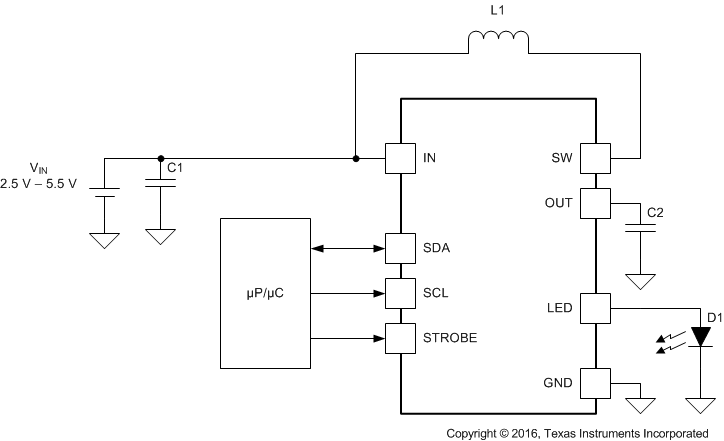
5 Pin Configuration and Functions

Pin Functions
| PIN | TYPE(1) | DESCRIPTION | |
|---|---|---|---|
| NAME | NO. | ||
| A1 | GND | G | Ground |
| A2 | IN | P | Input voltage connection. Connect IN to the input supply and bypass to GND with a 10-µF or larger ceramic capacitor. |
| B1 | SW | P | Drain connection for Internal NMOS and synchronous PMOS switches. |
| B2 | STROBE | I | Active high hardware flash enable. Drive STROBE high to turn on flash pulse. An internal pulldown resistor of 300 kΩ is between STROBE and GND. |
| C1 | OUT | P | Step-up DC-DC converter output. Connect a 10-µF ceramic capacitor between this terminal and GND. |
| C2 | SDA | I/O | I2C serial data input/output. |
| D1 | LED | P | High-side current source output for flash LED. |
| D2 | SCL | I | I2C serial clock input. |
6 Specifications
6.1 Absolute Maximum Ratings
over operating free-air temperature range (unless otherwise noted)(1)(2)| MIN | MAX | UNIT | ||
|---|---|---|---|---|
| IN, SW, OUT, LED | −0.3 | 6 | V | |
| SDA, SCL, STROBE | −0.3 | (VIN+ 0.3) w/ 6 V maximum | ||
| Continuous power dissipation(3) | Internally limited | |||
| Junction temperature, TJ-MAX | 150 | °C | ||
| Storage temperature, Tstg | −65 | 150 | °C | |
6.2 ESD Ratings
| VALUE | UNIT | |||
|---|---|---|---|---|
| V(ESD) | Electrostatic discharge | Human-body model (HBM), per ANSI/ESDA/JEDEC JS-001(1) | ±1000 | V |
| Charged-device model (CDM), per JEDEC specification JESD22-C101(2) | ±250 | |||
6.3 Recommended Operating Conditions
over operating free-air temperature range (unless otherwise noted)(1)(2)| MIN | MAX | UNIT | ||
|---|---|---|---|---|
| VIN | 2.5 | 5.5 | V | |
| Junction temperature, TJ | −40 | 125 | °C | |
| Ambient temperature, TA (3) | −40 | 85 | °C | |
6.4 Thermal Information
| THERMAL METRIC(1) | LM36010 | UNIT | |
|---|---|---|---|
| YKB (DSBGA) | |||
| 8 PINS | |||
| RθJA | Junction-to-ambient thermal resistance | 117.3 | °C/W |
| RθJC(top) | Junction-to-case (top) thermal resistance | 1.3 | °C/W |
| RθJB | Junction-to-board thermal resistance | 34.3 | °C/W |
| ΨJT | Junction-to-top characterization parameter | 0.5 | °C/W |
| ΨJB | Junction-to-board characterization parameter | 34.6 | °C/W |
6.5 Electrical Characteristics
TA = 25°C and VIN = 3.6 V, unless otherwise specified. Minimum and maximum limits apply over the full operating ambient temperature range (–40°C ≤ TA ≤ 85°C).(1)(2)| PARAMETER | TEST CONDITIONS | MIN | TYP | MAX | UNIT | ||
|---|---|---|---|---|---|---|---|
| CURRENT SOURCE SPECIFICATIONS | |||||||
| ILED | Current source accuracy | VOUT = 4 V , flash code = 0x7F = 1.5 A (3) | –10% | 1.5 | 10% | A | |
| VOUT = 4 V , torch code = 0x7F = 376 mA | –10% | 376 | 10% | mA | |||
| VHR | LED current source regulation voltage | ILED = 1.5 A | Flash | 550 | mV | ||
| ILED = 376 mA | Torch | 350 | |||||
| VOVP | Overvoltage Protection | ON threshold | 4.86 | 5 | 5.10 | V | |
| OFF threshold | 4.71 | 4.85 | 4.95 | ||||
| STEP-UP DC-DC CONVERTER SPECIFICATIONS | |||||||
| RPMOS | PMOS switch on-resistance | 175 | mΩ | ||||
| RNMOS | NMOS switch on-resistance | 130 | |||||
| ICL | Switch current limit | Reg 0x01, bit [5] = 0 | –15% | 1.9 | 15% | A | |
| Reg 0x01, bit [5] = 1 | –15% | 2.8 | 15% | ||||
| VUVLO | Undervoltage lockout threshold | Falling VIN | 2.5 | V | |||
| VIVFM | Input voltage flash monitor trip threshold | Reg 0x02, bits [7:5] = 000 | –3% | 2.9 | 3% | V | |
| IQ | Quiescent supply current | Device not switching, in pass mode | 0.3 | mA | |||
| ISB | Standby supply current | Device disabled 2.5 V ≤ VIN ≤ 5.5 V |
0.8 | 4 | µA | ||
| STROBE VOLTAGE SPECIFICATIONS | |||||||
| VIL | Input logic low | 2.5 V ≤ VIN ≤ 5.5 V | 0 | 0.4 | V | ||
| VIH | Input logic high | 1.2 | VIN | V | |||
| I2C-COMPATIBLE INTERFACE SPECIFICATIONS (SCL, SDA) | |||||||
| VIL | Input logic low | 2.5 V ≤ VIN ≤ 4.2 V | 0 | 0.4 | V | ||
| VIH | Input logic high | 1.2 | VIN | ||||
| VOL | Output logic low | ILOAD = 3 mA | 400 | mV | |||
6.6 Timing Requirements
| MIN | NOM | MAX | UNIT | ||
|---|---|---|---|---|---|
| t1 | SCL clock period | 2.4 | µs | ||
| t2 | Data in set-up time to SCL high | 100 | ns | ||
| t3 | Data out stable after SCL low | 0 | ns | ||
| t4 | SDA low set-up time to SCL low (start) | 100 | ns | ||
| t5 | SDA high hold time after SCL high (stop) | 100 | ns | ||
6.7 Switching Characteristics
over operating free-air temperature range (unless otherwise noted)| PARAMETER | TEST CONDITIONS | MIN | TYP | MAX | UNIT | |
|---|---|---|---|---|---|---|
| ƒSW | Switching frequency | 2.5 V ≤ VIN ≤ 5.5 V | -10% | 2 | 10% | MHz |
| -10% | 4 | 10% | ||||
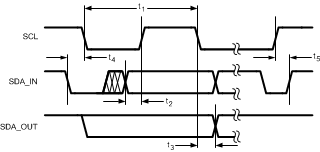 Figure 1. I2C-Compatible Interface Specifications
Figure 1. I2C-Compatible Interface Specifications
6.8 Typical Characteristics
TA = 25°C, VIN = 3.6 V, CIN = 10 µF, COUT = 10 µF, L = 1 µH, VLED = 3.4 V, Flash Time-out = 320 ms and Thermal Scale-Back (TSB) disabled, unless otherwise noted.
| ƒSW = 2 MHz | ICL = 2.8 A |

| ƒSW = 2 MHz | ICL = 2.8 A |
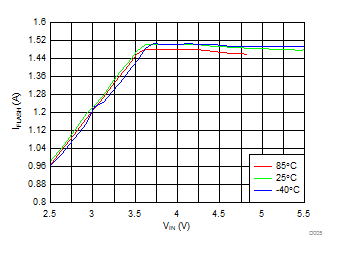
| ƒSW = 2 MHz | IFLASH = 1.5 A | |
| ICL = 1.9 A | Flash Time-out < 120 ms at 85°C | |

| ƒSW = 2 MHz | IFLASH = 1.2 A | |
| ICL = 1.9 A | Flash Time-out < 280 ms at 85°C | |

| ƒSW = 2 MHz | IFLASH = 1.03 A | ICL = 1.9 A |

| ƒSW = 2 MHz | IFLASH = 1.03 A | ICL = 2.8 A |

| ƒSW = 2 MHz | IFLASH = 0.75 A | ICL = 1.9 A |

| ƒSW = 2 MHz | IFLASH = 0.75 A | ICL = 2.8 A |

| ƒSW = 2 MHz |

| ƒSW = 2 MHz |

| ƒSW = 2 MHz | ITORCH = 376 mA | |

| ƒSW = 2 MHz | ITORCH = 258 mA | |

| Mode (Reg 0x01 bits[1:0]) = 01 (IR Mode) | ||


| ƒSW = 4 MHz | ICL = 2.8 A |

| ƒSW = 2 MHz | ICL = 2.8 A |

| ƒSW = 4 MHz | IFLASH = 1.5 A | |
| ICL = 1.9 A | Flash Time-out < 120 ms at 85°C | |

| ƒSW = 4 MHz | IFLASH = 1.2 A | |
| ICL = 1.9 A | Flash Time-out < 280 ms at 85°C | |

| ƒSW = 4 MHz | IFLASH = 1.03 A | ICL = 1.9 A |

| ƒSW = 4 MHz | IFLASH = 1.03 A | ICL = 2.8 A |
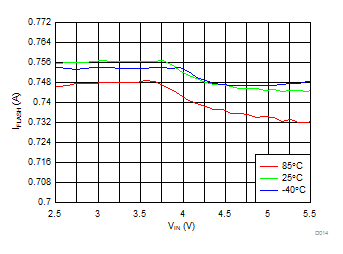
| ƒSW = 4 MHz | IFLASH = 0.75 A | ICL = 1.9 A |

| ƒSW = 4 MHz | IFLASH = 0.75 A | ICL = 2.8 A |

| ƒSW = 4 MHz |

| ƒSW = 2 MHz |

| ƒSW = 4 MHz | ITORCH = 376 mA | |

| ƒSW = 2 MHz | ITORCH = 188 mA | |

| Mode (Reg 0x01 bits[1:0]) = 10 (Torch Mode) | ||
7 Detailed Description
7.1 Overview
The LM36010 is a high-power white LED flash driver capable of delivering up to 1.5 A to the LED. The device incorporates a 2-MHz or 4-MHz constant frequency-synchronous current-mode PWM boost converter and a high-side current source to regulate the LED current over the 2.5-V to 5.5-V input voltage range.
The LM36010 PWM DC-DC boost converter switches and boosts the output to maintain at least VHR across the current source. This minimum headroom voltage ensures that the current source remains in regulation. If the input voltage is above the LED voltage + current source headroom voltage the device does not switch, but turns the PFET on continuously (pass mode). In pass mode, the drop across the current source is the difference between (VIN - ILED × RPMOS) and VLED.
The device has one logic input for a hardware flash enable (STROBE). This logic input has an internal 300-kΩ (typical) pulldown resistor to GND.
Additional features of the device include an input voltage monitor that can reduce the flash current during low VIN conditions and a temperature based current scale-back feature that forces the flash current to the set torch level if the on-chip junction temperature reaches 125°C.
Control is done via an I2C-compatible interface. This includes adjustment of the flash and torch current levels, changing the switch current limit, and changing the flash time-out duration. Additionally, there are flag and status bits that indicate flash current time-out, LED over-temperature condition, LED failure (open/short), device thermal shutdown, thermal current scale-back, and VIN undervoltage conditions.
7.2 Functional Block Diagram
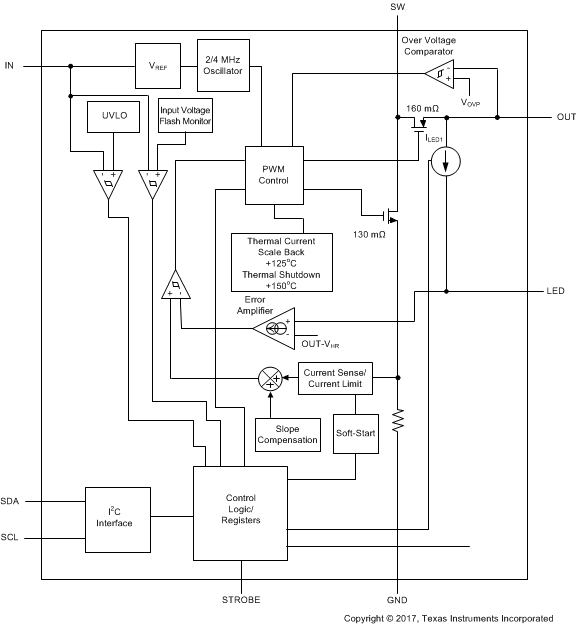
7.3 Feature Description
7.3.1 Flash Mode
In flash mode, the LED current source provides 128 target current levels from 11 mA to 1.5 A, set by the LED Flash Brightness Register (0x03 bits [6:0]). Flash mode is activated by the Enable Register (0x01), setting mode M1, M0 (bits [1:0]) to 11. Once the flash sequence is activated, the LED current source ramps up to the programmed flash current by stepping through all current steps until the programmed current is reached. The headroom on the current source is regulated to provide 11 mA to 1.5 A.
When flash mode is enabled using the mode M1, M0 (bits [1:0]) of the Enable Register (0x01), the mode bits in the Enable Register are cleared after a flash time-out event.
7.3.2 Torch Mode
In torch mode, the LED current source provides 128 target current levels from 2.4 mA to 376 mA, set by the LED Torch Brightness Register (0x04 bits [6:0]). Torch mode is activated by the Enable Register (0x01), setting mode M1, M0 (bits [1:0]) to 10. Once the TORCH sequence is activated, the LED current source ramps up to the programmed torch current by stepping through all current steps until the programmed current is reached. The rate at which the current ramps is determined by the value chosen in the Torch Ramp bit [0] in Timing Register (0x02).
7.3.3 IR Mode
In IR mode, the target LED current is equal to the value stored in the LED Flash Brightness Register (0x03 bits [7:0]). When IR mode is enabled by the Enable Register (0x01) setting mode M1, M0 (bits [1:0]) to 01, the boost converter turns on and sets the output equal to the input (pass mode). In IR mode, toggling the STROBE pin enables and disables the LED current source. The STROBE pin can only be set to be Level sensitive, as all timing of the IR pulse is externally controlled. In IR mode, the current source does not control the ramp rate of the LED output. The current transitions immediately from off to on and then on to off.
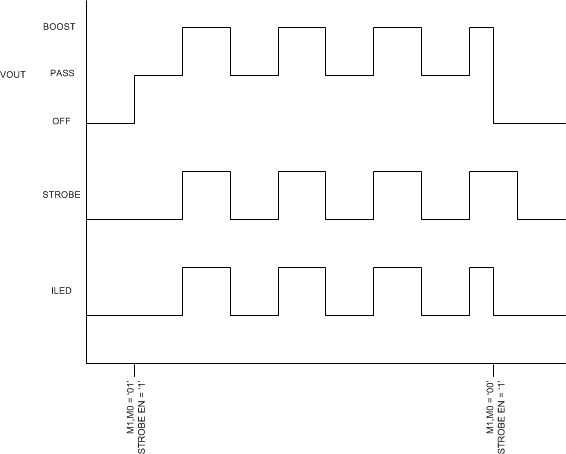
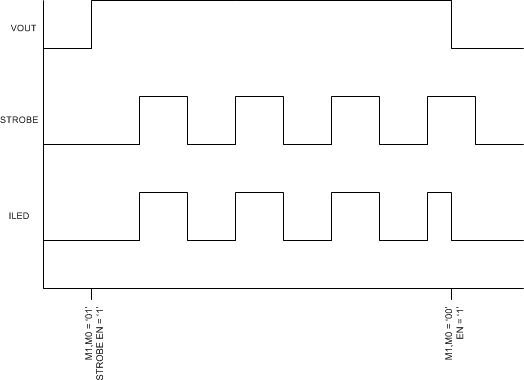
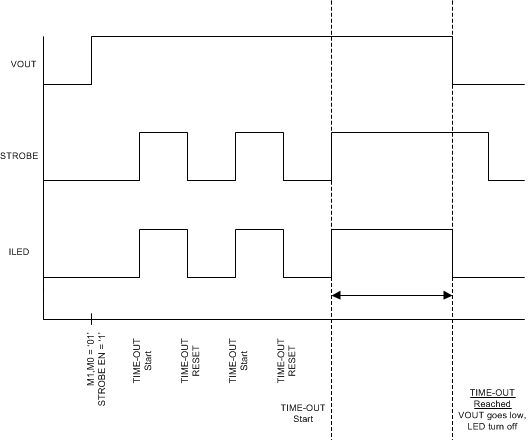
7.4 Device Functioning Modes
7.4.1 Start-Up (Enabling The Device)
At turnon the LED current source steps through each FLASH or TORCH level until the target LED current is reached. This gives the device a controlled turnon and limits inrush current from the VIN supply. The target LED flash and the target LED torch currents are set by the LED Flash Brightness Register (0x03 bits [6:0]) and LED Torch Brightness Register (0x04 bits [6:0]) respectively.
7.4.2 Pass Mode
The LM36010 starts up in pass mode and stays there until boost mode is needed to maintain regulation. If the voltage difference between VOUT and VLED falls below VHR, the device switches to boost mode. In pass mode, the boost converter does not switch, the synchronous PFET turns fully on bringing VOUT up to VIN – ILED × RPMOS, and the inductor current is not limited by the peak current limit.
7.4.3 Input Voltage Flash Monitor (IVFM)
The LM36010 has the ability to adjust the flash current based upon the voltage level present at the IN pin utilizing the input voltage flash monitor (IVFM). The adjustable threshold IVFM-D ranges from 2.9 V to 3.6 V in 100-mV steps and is set by Configuration Register (0x02) bits [7:5]. Additionally, the IVFM-D threshold sets the input voltage boundary that forces the LM36010 to stop ramping the flash current during start-up.
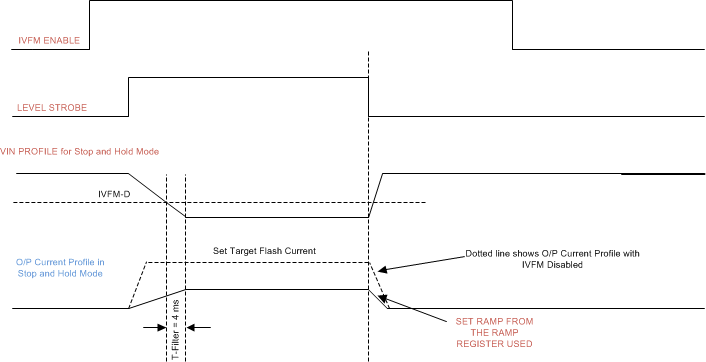 Figure 32. IVFM Mode
Figure 32. IVFM Mode
7.4.4 Fault/Protections
Upon a fault condition, the LM36010 sets the appropriate flag(s) in the Flags Register (0x05) and switches into stand-by mode obtained by clearing the mode M1, M0 (bits [1:0]) of the Enable Register (0x01). The LM36010 remains in standby until an I2C read of the Flags Register. I2C read of the Flags Register clears the flags and the fault status can be re-checked. If the fault(s) is still present, the LM36010 re-sets the appropriate flag bits and enters stand-by again.
7.4.4.1 Overvoltage Protection (OVP)
The output voltage is limited to typically 5 V (see VOVP specification in the Electrical Characteristics). In situations such as an open LED, the LM36010 raises the output voltage in order to keep the LED current at its target value. When VOUT reaches 5 V (typical), the overvoltage comparator trips and turns off the internal NFET. When OVP condition is present for three consecutive OVP events, LM36010 enters stand-by mode and OVP flag (bit [0]) of Flags Register (0x01) is set. Checking for three consecutive events prevents forcing the device to shut down due to momentary OVP condition. When VOUT falls below the VOVP off threshold, the LM36010 switches again.
7.4.4.2 Input Voltage Flash Monitor (IVFM)
When the input voltage crosses the IVFM-D value, programmed by Configuration Register (0x02) bits [7:5], the LM36010 sets the IVFM flag (bit [6]) of Flags Register (0x05).
7.4.4.3 LED and/or VOUT Short Fault
LM36010 enters stand-by mode from flash or torch mode and VLED Short Fault flag (bit [5]) of Flags Register (0x05) is set, if the LED output and/or VOUT experiences a short condition. An LED short condition occurs if the voltage at the LED pin goes below 500 mV (typical). There is a deglitch time of 256 µs before the LED short flag is valid, and a deglitch time of 2.048 ms before the VOUT short flag is valid. The LED and/or VOUT short fault can be reset to 0 by removing power to the LM36010, or setting the software reset field (Register 0x06 bit [7]) to a 1, or by reading back the Flags Register.
7.4.4.4 Current Limit (OCP)
The LM36010 features two selectable inductor current limits, 1.9A and 2.8A, programmable through the I2C-compatible interface by writing to Register 0x01 bit [5] . When the inductor current limit is reached, the LM36010 terminates the charging phase of the switching cycle and sets the OCP flag (bit [4]) of Flags Register (0x05). However, the mode M1, M0 (bits [1:0]) are not cleared as the device operates at current limit. Switching resumes at the start of the next switching period.
In pass mode, there is no mechanism to limit the current as the current does not flow through the NMOS, which senses the current limit.
In the boost mode or the pass mode, if VOUT falls below 2.3 V, the device stops switching, and the PFET operates as a current source limiting the current to 200 mA. This prevents the LM36010 from drawing excessive current from the battery during output short-circuit conditions.
7.4.4.5 Thermal Scale-Back (TSB)
When the LM36010 die temperature reaches 125°C, the thermal scale-back (TSB) circuit trips and TSB flag (bit [2]) of Flags Register (0x05) is set. The LED current then shifts to torch current level, set by the LED Torch Brightness Register (0x04 bits [6:0]) for the duration of the flash pulse, set by the flash time-out in the Configuration Register (0x02 bits [4:1]) After I2C read of the Flags Register and upon re-flash, if the die temperature is still above 125°C, the LM36010 re-enters into torch current level and sets the TSB flag bit again.
7.4.4.6 Thermal Shutdown (TSD)
When the LM36010 die temperature reaches 150°C, the thermal shutdown (TSD) circuit trips, forcing the LM36010 into standby and writing a 1 to the TSD flag (bit [2]) of the Flags Register (0x05). The LM36010 restarts only after the Flags Register is read, which clears the fault flag. Upon restart, if the die temperature is still above 150°C, the LM36010 resets the TSD flag and re-enters standby.
7.4.4.7 Undervoltage Lockout (UVLO)
The LM36010 has an internal comparator that monitors the voltage at IN pin. If the input voltage drops to 2.5 V, the UVLO flag (bit [1]) of Flags Register (0x05) is set and the LM36010 switches to stand-by mode. After the UVLO flag is set, even if the input voltage rises above 2.5 V, the LM36010 is not available for operation until there is an I2C read of the Flags Register. Upon an I2C read of the Flags Register, the UVLO fault is cleared and normal operation can resume.
7.4.4.8 Flash Time-out (FTO)
The LM36010 sources the flash current for the time period set by Flash Time-out (0x02 bits [4:1]). The LED current source has 16 time-out levels ranging from 40 ms to 1600 ms.
7.5 Programming
7.5.1 Control Truth Table
| M1 (Register 0x01 bit[1]) | M0 (Register 0x01 bit[0]) | STROBE EN (Register 0x01 bit[2]) | STROBE PIN | ACTION |
|---|---|---|---|---|
| 0 | 0 | 0 | X | Standby |
| 0 | 0 | 1 | pos edge | Ext flash |
| 1 | 0 | X | X | Int torch |
| 1 | 1 | X | X | Int flash |
| 0 | 1 | 0 | X | IR LED standby |
| 0 | 1 | 1 | 0 | IR LED standby |
| 0 | 1 | 1 | pos edge | IR LED enabled |
7.5.2 I2C-Compatible Interface
7.5.2.1 Data Validity
The data on SDA must be stable during the HIGH period of the clock signal (SCL). In other words, the state of the data line can only be changed when SCL is LOW.
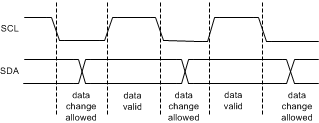 Figure 33. Data Validity Data
Figure 33. Data Validity Data
A pullup resistor between the VIO line of the controller and SDA must be greater than [(VIO – VOL) / 3 mA] to meet the VOL requirement on SDA. Using a larger pullup resistor results in lower switching current with slower edges, while using a smaller pullup resistor results in higher switching currents with faster edges.
7.5.2.2 Start and Stop Conditions
START and STOP conditions classify the beginning and the end of the I2C session. A START condition is defined as the SDA signal transitioning from HIGH to LOW while SCL line is HIGH. A STOP condition is defined as the SDA transitioning from LOW to HIGH while SCL is HIGH. The I2C master always generates START and STOP conditions. The I2C bus is considered busy after a START condition and free after a STOP condition. During data transmission, the I2C master can generate repeated START conditions. First START and repeated START conditions are equivalent, function-wise.
 Figure 34. Start and Stop Conditions
Figure 34. Start and Stop Conditions
7.5.2.3 Transferring Data
Every byte put on the SDA line must be eight bits long, with the most significant bit (MSB) transferred first. Each byte of data has to be followed by an acknowledge bit. The acknowledge related clock pulse is generated by the master. The master releases the SDA line (HIGH) during the acknowledge clock pulse. The LM36010 pulls down the SDA line during the 9th clock pulse, signifying an acknowledge. The LM36010 generates an acknowledge after each byte is received. There is no acknowledge created after data is read from the device.
After the START condition, the I2C master sends a chip address. This address is seven bits long followed by an eighth bit which is a data direction bit (R/W). The LM36010 7-bit address is 0x64. For the eighth bit, a 0 indicates a WRITE, and a 1 indicates a READ. The second byte selects the register to which the data is written. The third byte contains data to write to the selected register.
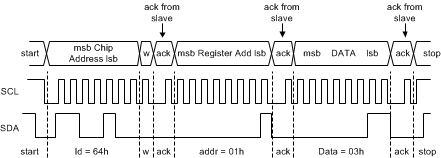 Figure 35. Write Cycle W = Write (SDA = 0) R = Read (SDA = 1) Ack = Acknowledge
Figure 35. Write Cycle W = Write (SDA = 0) R = Read (SDA = 1) Ack = Acknowledge (SDA Pulled Down by Either Master or Slave) ID = Chip Address, 64h for LM36010
7.5.2.4 I2C-Compatible Chip Address
The device address for the LM36010 is 1100100 (0x64). After the START condition, the I2C-compatible master sends the 7-bit address followed by an eighth read or write bit (R/W). R/W = 0 indicates a WRITE and R/W = 1 indicates a READ. The second byte following the device address selects the register address to which the data is written. The third byte contains the data for the selected register.
 Figure 36. I2C-Compatible Chip Address
Figure 36. I2C-Compatible Chip Address
7.6 Register Descriptions
| REGISTER NAME | INTERNAL HEX ADDRESS | POWER ON/RESET VALUE |
|---|---|---|
| LM36010 | ||
| Enable Register | 0x01 | 0x20 |
| Configuration Register | 0x02 | 0x15 |
| LED Flash Brightness Register | 0x03 | 0x00 |
| LED Torch Brightness Register | 0x04 | 0x00 |
| Flags Register | 0x05 | 0x00 |
| Device ID Register | 0x06 | 0x01 |
7.6.1 Enable Register (0x01)
| Bit 7 | Bit 6 | Bit 5 | Bit 4 | Bit 3 | Bit 2 | Bit 1 | Bit 0 |
|---|---|---|---|---|---|---|---|
| Boost Mode
0 = Normal (Default) 1 = Pass Mode Only |
Boost Frequency Select
0 = 2 MHz (Default) 1 = 4 MHz |
Boost Current Limit Setting
0 = 1.9 A 1 = 2.8 A (Default) |
IVFM Enable
0 = Disabled (Default) 1 = Enabled |
Strobe Type
0 = Level Triggered (Default) 1 = Edge Triggered |
Strobe Enable
0 = Disabled (Default ) 1 = Enabled |
Mode Bits: M1, M0
00 = Standby (Default) 01 = IR Drive 10 = Torch 11 = Flash |
|
NOTE
Edge strobe mode is not valid in IR MODE. Switching between level and edge strobe types while the device is enabled is not recommended.
In edge or level strobe mode, TI recommends that the trigger pulse width be set greater than 1 ms to ensure proper turn-on of the device.
7.6.2 Configuration Register (0x02)
| Bit 7 | Bit 6 | Bit 5 | Bit 4 | Bit 3 | Bit 2 | Bit 1 | Bit 0 |
|---|---|---|---|---|---|---|---|
| IVFM Levels (IVFM-D)
000 = 2.9 V (Default) 001 = 3 V 010 = 3.1 V 011 = 3.2 V 100 = 3.3 V 101 = 3.4 V 110 = 3.5 V 111 = 3.6 V |
Flash Time-out Duration
0000 = 40 ms 0001 = 80 ms 0010 = 120 ms 0011 = 160 ms 0100 = 200 ms 0101 = 240 ms 0110 = 280 ms 0111 = 320 ms 1000 = 360 ms 1001 = 400 ms 1010 = 600 ms (Default) 1011 = 800 ms 1100 = 1000 ms 1101 = 1200 ms 1110 = 1400 ms 1111 = 1600 ms |
Torch Ramp
0 = No Ramp 1 = 1 ms (default) |
|||||
NOTE
On the LM36010, special care must be taken with regards to thermal management when using time-out values greater than 500 ms. Depending on the PCB layout, input voltage, and output current, it is possible to have the internal thermal shutdown circuit trip prior to reaching the desired flash time-out value.
7.6.3 LED Flash Brightness Register (0x03)
| Bit 7 | Bit 6 | Bit 5 | Bit 4 | Bit 3 | Bit 2 | Bit 1 | Bit 0 |
|---|---|---|---|---|---|---|---|
| Thermal Current Scale-Back
0 = Disabled 1 = Enabled (default) If enabled, the LED current shifts to torch current level if TJ reaches 125 °C |
LED Flash Brightness Level
0000000 = 11 mA (Default) ....................... 00010101 (0x15) = 0.257 A ....................... 0111111 (0x3F) = 0.75 A ....................... 0101111 (0x5F) = 1.03 A ....................... 01100110 (0x66) = 1.2 A ....................... 1111111 (0x7F) = 1.5 A |
||||||
7.6.4 LED Torch Brightness Register (0x04)
| Bit 7 | Bit 6 | Bit 5 | Bit 4 | Bit 3 | Bit 2 | Bit 1 | Bit 0 |
|---|---|---|---|---|---|---|---|
| RFU | LED Torch Brightness Levels
0000000 = 2.4 mA (Default) ....................... 00010101 (0x15) = 64 mA ....................... 0111111 (0x3F) = 188 mA ....................... 0101111 (0x5F) = 258 mA ....................... 01100110 (0x66) = 302 mA ....................... 1111111 (0x7F) = 376 mA |
||||||
7.6.5 Flags Register (0x05)
| Bit 7 | Bit 6 | Bit 5 | Bit 4 | Bit 3 | Bit 2 | Bit 1 | Bit 0 |
|---|---|---|---|---|---|---|---|
| OVP Fault | IVFM Trip Flag | VOUT / VLED Short Fault | Current Limit Flag | Thermal Current Scale-back (TSB) Flag | Thermal Shutdown (TSD) Fault | UVLO Fault | Flash Time-Out Flag |
7.6.6 Device ID and RESET Register (0x06)
| Bit 7 | Bit 6 | Bit 5 | Bit 4 | Bit 3 | Bit 2 | Bit 1 | Bit 0 |
|---|---|---|---|---|---|---|---|
| Software RESET
0 = Normal (default) 1 = Force device RESET |
RFU | Device ID
000 |
Silicon Revision Bits
001 |
||||
8 Applications and Implementation
NOTE
Information in the following applications sections is not part of the TI component specification, and TI does not warrant its accuracy or completeness. TI’s customers are responsible for determining suitability of components for their purposes. Customers should validate and test their design implementation to confirm system functionality.
8.1 Application Information
The LM36010 can drive a flash LED at currents up to 1.5 A. The 2-MHz or 4-MHz DC-DC boost regulator allows for the use of small value discrete external components.
8.2 Typical Application
 Figure 37. LM36010 Typical Application
Figure 37. LM36010 Typical Application
8.2.1 Design Requirements
Example requirements based on default register values:
Table 1. Design Parameters
| DESIGN PARAMETER | EXAMPLE VALUE |
|---|---|
| Input voltage range | 2.5 V to 5.5 V |
| Brightness control | I2C Register |
| LED configuration | 1 flash LED |
| Boost switching frequency | 2 MHz (4 MHz selectable) |
| Flash brightness | 1.5-A maximum current |
8.2.2 Detailed Design Procedure
8.2.2.1 Thermal Performance
Output power is limited by three things: the peak current limit, the ambient temperature, and the maximum power dissipation in the package. If the die temperature of the device is below the absolute maximum rating of 125°C, the maximum output power can be over 6 W. However, any appreciable output current causes the internal power dissipation to increase and therefore increase the die temperature. Any circuit configuration must ensure that the die temperature remains below 125°C taking into account the ambient temperature derating. The thermal scale-back protection (TSB) helps ensure that temperature requirement is held valid. If the TSB feature is disabled, thermal shutdown (TSD) is the next level of protection for the device, which is set to 150°C. This mechanism cannot be disabled, and operation of the device above 125°C is not ensured by the electrical specification.
In boost mode, where VIN < VLED + VHR, the power dissipation can be approximated by Equation 1:

When the device is in pass mode, where VIN > VLED + VHR, the power dissipation equals:

Use Equation 3 to calculate the junction temperature (TJ) of the device:

Note that these equations only provide approximation of the junction temperature and do not take into account thermal time constants, which play a large role in determining maximum deliverable output power and flash durations.
8.2.2.2 Output Capacitor Selection
The LM36010 is designed to operate with a 10-µF ceramic output capacitor. When the boost converter is running, the output capacitor supplies the load current during the boost converter on-time. When the NMOS switch turns off, the inductor energy is discharged through the internal PMOS switch, supplying power to the load and restoring charge to the output capacitor. This causes a sag in the output voltage during the on-time and a rise in the output voltage during the off-time. Therefore, choose the output capacitor to limit the output ripple to an acceptable level depending on load current and input or output voltage differentials and also to ensure the converter remains stable.
Larger capacitors such as a 22-µF or capacitors in parallel can be used if lower output voltage ripple is desired. To estimate the output voltage ripple considering the ripple due to capacitor discharge (ΔVQ) and the ripple due to the capacitors ESR (ΔVESR), use Equation 4 and Equation 5:
For continuous conduction mode, the output voltage ripple due to the capacitor discharge is:

The output voltage ripple due to the output capacitors ESR is found by:


In ceramic capacitors, the ESR is very low so the assumption is that 80% of the output voltage ripple is due to capacitor discharge and 20% from ESR. Table 2 lists different manufacturers for various output capacitors and their case sizes suitable for use with the LM36010.
8.2.2.3 Input Capacitor Selection
Choosing the correct size and type of input capacitor helps minimize the voltage ripple caused by the switching of the boost converter and reduces noise on the input pin of the boost converter that can feed through and disrupt internal analog signals. In the typical application circuit a 10-µF ceramic input capacitor works well. It is important to place the input capacitor as close as possible to the LM36010 input (IN) pin. This reduces the series resistance and inductance that can inject noise into the device due to the input switching currents. Table 2 lists various input capacitors recommended for use with the LM36010.
Table 2. Recommended Input/Output Capacitors (X5R/X7R Dielectric)
| MANUFACTURER | PART NUMBER | VALUE | CASE SIZE | VOLTAGE RATING |
|---|---|---|---|---|
| TDK Corporation | C1608JB0J106M | 10 µF | 0603 (1.6 mm × 0.8 mm × 0.8 mm) | 6.3 V |
| TDK Corporation | C2012JB1A106M | 10 µF | 0805 (2 mm × 1.25 mm × 1.25 mm) | 10 V |
| Murata | GRM188R60J106M | 10 µF | 0603 (1.6 mm × 0.8 mm × 0.8 mm) | 6.3 V |
| Murata | GRM21BR61A106KE19 | 10 µF | 0805 (2 mm × 1.25 mm × 1.25 mm) | 10 V |
8.2.2.4 Inductor Selection
The LM36010 is designed to use a 0.47-µH or 1-µH inductor. Table 3 lists various inductors and their manufacturers that work well with the LM36010. When the device is boosting (VOUT > VIN) the inductor is typically the largest area of efficiency loss in the circuit. Therefore, choosing an inductor with the lowest possible series resistance is important. Additionally, the saturation rating of the inductor must be greater than the maximum operating peak current of the LM36010. This prevents excess efficiency loss that can occur with inductors that operate in saturation. For proper inductor operation and circuit performance, ensure that the inductor saturation and the peak current limit setting of the LM36010 are greater than IPEAK in Equation 6:


where
- ƒSW = 2 or 4 MHz
Efficiency details can be found in the Application Curves.
Table 3. Recommended Inductors
| MANUFACTURER | L | PART NUMBER | DIMENSIONS (L×W×H) | ISAT | RDC |
|---|---|---|---|---|---|
| TOKO | 0.47 µH | DFE201610P-R470M | 2 mm × 1.6 mm × 1 mm | 4.1 A | 32 mΩ |
| TOKO | 1 µH | DFE201610P-1R0M | 2 mm × 1.6 mm × 1 mm | 3.7 A | 58 mΩ |
8.2.3 Application Curves
TA = 25°C, VIN = 3.6 V, CIN = 10 µF, COUT = 10 µF, L = 1 µH, VLED = 3.4 V, Flash Time-out = 320 ms and Thermal Scale-Back (TSB) disabled, unless otherwise noted.
| ƒSW = 2 MHz | ICL = 2.8 A |

| ƒSW = 2 MHz | ICL = 2.8 A |

| ƒSW = 2 MHz | IFLASH = 1.5 A | |
| ICL = 1.9 A | Flash Time-out < 120 ms at 85°C | |

| ƒSW = 2 MHz | IFLASH = 1.2 A | |
| ICL = 1.9 A | Flash Time-out < 280 ms at 85°C | |

| ƒSW = 2 MHz | IFLASH = 1.03 A | ICL = 1.9 A |

| ƒSW = 2 MHz | IFLASH = 1.03 A | ICL = 2.8 A |

| ƒSW = 2 MHz | IFLASH = 0.75 A | ICL = 1.9 A |

| ƒSW = 2 MHz | IFLASH = 0.75 A | ICL = 2.8 A |

| ƒSW = 2 MHz |

| ƒSW = 2 MHz |

| ƒSW = 2 MHz | ITORCH = 376 mA | |

| ƒSW = 2 MHz | ITORCH = 258 mA | |

| Time (400 µs/DIV) | ||
| Mode bits (Reg 0x01 bit[1:0]) = 11 (Flash Mode) |

| Time (2 ms/DIV) | ||

| Time (4 ms/DIV) | ||
| Mode bits (Reg 0x01 bit[1:0]) = 00 (Standby Mode) |

| Time (100 ms/DIV) | ||
| STROBE Enabled (Reg 0x01 bit[2] = 1) | ||
| Level Triggered (Reg 0x01 bit[3] = 0) | ||
| Strobe pulse = 100 ms |

| Time (400 µs/DIV) | ||
| Reg 0x01 = 0x26 |

| Time (400 µs/DIV) | ||
| Reg 0x01 = 0x2C |

| Time (400 µs/DIV) | ||
| Reg 0x01 = 0xA6 |

| Time (400 µs/DIV) | ||
| Reg 0x01 = 0xAC |

| Time (200 ns/DIV) | ||
| ƒSW = 2 MHz | ||

| Time (400 µs/DIV) | ||||
| Reg 0x01 = 0x13 | IVFM Trip Level (Reg 0x02 bits[7:5]) = 001 (3 V) | |||

| ƒSW = 4 MHz | ICL = 2.8 A |

| ƒSW = 2 MHz | ICL = 2.8 A |

| ƒSW = 4 MHz | IFLASH = 1.5 A | |
| ICL = 1.9 A | Flash Time-out < 120 ms at 85°C | |

| ƒSW = 4 MHz | IFLASH = 1.2 A | |
| ICL = 1.9 A | Flash Time-out < 280 ms at 85°C | |

| ƒSW = 4 MHz | IFLASH = 1.03 A | ICL = 1.9 A |

| ƒSW = 4 MHz | IFLASH = 1.03 A | ICL = 2.8 A |

| ƒSW = 4 MHz | IFLASH = 0.75 A | ICL = 1.9 A |

| ƒSW = 4 MHz | IFLASH = 0.75 A | ICL = 2.8 A |

| ƒSW = 4 MHz |

| ƒSW = 2 MHz |

| ƒSW = 4 MHz | ITORCH = 376 mA | |

| ƒSW = 2 MHz | ITORCH = 188 mA | |

| Time (100 ms/DIV) | ||
| Flash Time-out (Reg 0x02 bits[4:1]) = 0111 (320 ms) |

| Time (400 µs/DIV) | ||
| Mode bits (Reg 0x01 bit[1:0]) = 10 (Torch Mode) |

| Time (400 µs/DIV) | ||
| STROBE Enabled (Reg 0x01 bit[2] = 1) |

| Time (100 ms/DIV) | ||
| STROBE Enabled (Reg 0x01 bit[2] = 1) | ||
| Edge Triggered (Reg 0x01 bit[3] = 1) | ||
| Flash Time-out = 320 ms |

| Time (400 µs/DIV) | ||
| Reg 0x01 = 0x27 |

| Time (400 µs/DIV) | ||
| Reg 0x01 = 0x24 |

| Time (400 µs/DIV) | ||
| Reg 0x01 = 0xA7 |

| Time (400 µs/DIV) | ||
| Reg 0x01 = 0xA4 |

| Time (200 ns/DIV) | ||
| ƒSW = 4 MHz | ||
9 Power Supply Recommendations
The LM36010 is designed to operate from an input voltage supply range between 2.5 V and 5.5 V. This input supply must be well regulated and capable to supply the required input current. If the input supply is located far from the LM36010 additional bulk capacitance may be required in addition to the ceramic bypass capacitors.
10 Layout
10.1 Layout Guidelines
The high switching frequency and large switching currents of the LM36010 make the choice of layout important. The following steps are to be used as a reference to ensure the device is stable and maintains proper LED current regulation across its intended operating voltage and current range.
- Place CIN on the top layer (same layer as the LM36010) and as close as possible to the device. The input capacitor conducts the driver currents during the low-side MOSFET turnon and turnoff and can detect current spikes over 1 A in amplitude. Connecting the input capacitor through short, wide traces to both the IN and GND pins reduces the inductive voltage spikes that occur during switching which can corrupt the VIN line.
- Place COUT on the top layer (same layer as the LM36010) and as close as possible to the OUT and GND pins. The returns for both CIN and COUT must come together at one point, as close as possible to the GND pin. Connecting COUT through short, wide traces reduce the series inductance on the OUT and GND pins that can corrupt the VOUT and GND lines and cause excessive noise in the device and surrounding circuitry.
- Connect the inductor on the top layer close to the SW pin. There must be a low-impedance connection from the inductor to SW due to the large DC inductor current, and at the same time the area occupied by the SW node must be small so as to reduce the capacitive coupling of the high dV/dT present at SW that can couple into nearby traces.
- Avoid routing logic traces near the SW node so as to avoid any capacitively coupled voltages from SW onto any high-impedance logic lines such as STROBE, SDA, and SCL. A good approach is to insert an inner layer GND plane underneath the SW node and between any nearby routed traces. This creates a shield from the electric field generated at SW.
- Terminate the flash LED cathode directly to the GND pin of the LM36010. If possible, route the LED return with a dedicated path so as to keep the high amplitude LED current out of the GND plane. For a flash LED that is routed relatively far away from the LM36010, a good approach is to sandwich the forward and return current paths over the top of each other on two layers. This helps reduce the inductance of the LED current path.
10.2 Layout Example
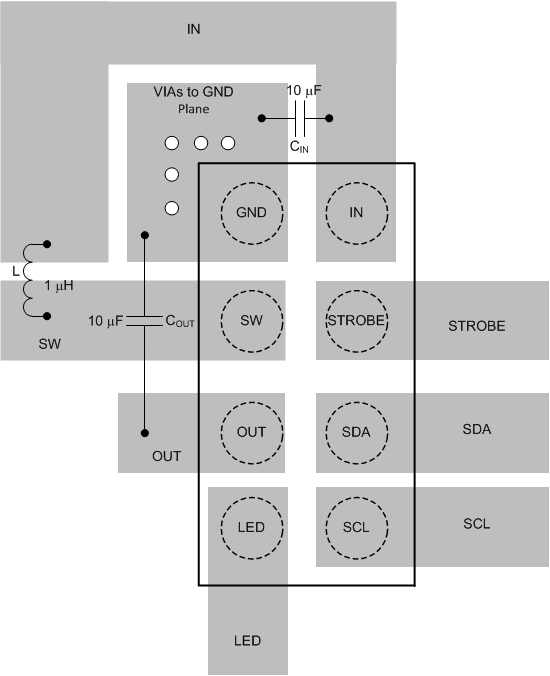 Figure 81. LM36010 Layout Example
Figure 81. LM36010 Layout Example
11 Device and Documentation Support
11.1 Device Support
11.1.1 Third-Party Products Disclaimer
TI'S PUBLICATION OF INFORMATION REGARDING THIRD-PARTY PRODUCTS OR SERVICES DOES NOT CONSTITUTE AN ENDORSEMENT REGARDING THE SUITABILITY OF SUCH PRODUCTS OR SERVICES OR A WARRANTY, REPRESENTATION OR ENDORSEMENT OF SUCH PRODUCTS OR SERVICES, EITHER ALONE OR IN COMBINATION WITH ANY TI PRODUCT OR SERVICE.
11.2 Documentation Support
11.2.1 Related Documentation
For related documentation, see the following:
11.3 Receiving Notification of Documentation Updates
To receive notification of documentation updates, navigate to the device product folder on ti.com. In the upper right corner, click on Alert me to register and receive a weekly digest of any product information that has changed. For change details, review the revision history included in any revised document.
11.4 Community Resources
The following links connect to TI community resources. Linked contents are provided "AS IS" by the respective contributors. They do not constitute TI specifications and do not necessarily reflect TI's views; see TI's Terms of Use.
-
TI E2E™ Online Community TI's Engineer-to-Engineer (E2E) Community. Created to foster collaboration among engineers. At e2e.ti.com, you can ask questions, share knowledge, explore ideas and help solve problems with fellow engineers.
-
Design Support TI's Design Support Quickly find helpful E2E forums along with design support tools and contact information for technical support.
11.5 Trademarks
E2E is a trademark of Texas Instruments.
All other trademarks are the property of their respective owners.
11.6 Electrostatic Discharge Caution

This integrated circuit can be damaged by ESD. Texas Instruments recommends that all integrated circuits be handled with appropriate precautions. Failure to observe proper handling and installation procedures can cause damage.
ESD damage can range from subtle performance degradation to complete device failure. Precision integrated circuits may be more susceptible to damage because very small parametric changes could cause the device not to meet its published specifications.
11.7 Glossary
SLYZ022 — TI Glossary.
This glossary lists and explains terms, acronyms, and definitions.
12 Mechanical, Packaging, and Orderable Information
The following pages include mechanical, packaging, and orderable information. This information is the most current data available for the designated devices. This data is subject to change without notice and revision of this document. For browser-based versions of this data sheet, refer to the left-hand navigation.


